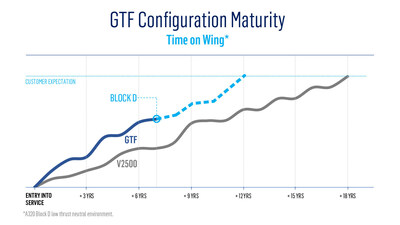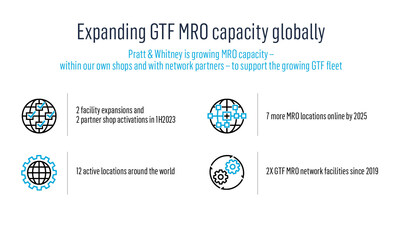- Extremely strong demand for GTF engines – more than 10,000 customer orders and commitments.
- Overall engine durability is better than V2500 at the same point in the engine’s lifecycle and Pratt & Whitney continues to invest to drive higher time on wing for customers.
- Aftermarket capacity is in place today to support the GTF fleet. More engines are being returned to service than are being removed for maintenance and as a result, Pratt & Whitney sees aircraft on ground (AOG) rates coming down through the end of 2023.
- Making progress to address persistent industry-wide supply chain constraints. For example, casting production is up by more than 40% year to date.
- GTF Advantage will be certified in mid-2024, achieving mature levels of durability at entry into service, especially in hot and harsh environments, with enhancements across the hot section of the engine.
“The GTF engine is a once-in-a-generation program that has shaped the future of sustainable aviation – delivering up to 20% less fuel and CO2 per trip and up to 25% per seat,” said Matt Teicholz, vice president of engineering for GTF engine programs at Pratt & Whitney. “Our operators know that the GTF is the most fuel-efficient and sustainable engine for single-aisle aircraft. Make no mistake – the geared fan is the architecture of today and tomorrow.”
With over 10,000 engine orders and commitments booked to date across three aircraft families, there is strong demand for GTF-powered aircraft, with demand for 30,000 single-aisle aircraft forecasted over the next 20 years.
Since the GTF engine first entered service, it has delivered on fuel efficiency, emissions and noise footprint, and Pratt & Whitney has continued to introduce improvements to increase reliability and durability. The company has met the target level for dispatch reliability – or the ability to depart on-time for a scheduled flight – which is now at a mature engine level of 99.96%.
With respect to durability, Pratt & Whitney has improved time on wing – or how long engines can be operated before needing to be removed for maintenance – since program inception.
“To meet our customers’ expectations, we need to be able produce highly efficient, reliable engines that are also highly durable, with long time on wing between shop visits,” said Rick Deurloo, president of Commercial Engines at Pratt & Whitney. “However, this metric is not yet at the level we expect, which has put stress on the operations of the fleet.”
Like other programs, time on wing varies depending on mission and operating environment. Approximately 75 percent of the fleet is operating in cooler environments and these customers are experiencing time on wing that the company expected at this point in the program. In fact, the GTF time on wing compares favorably to the V2500 eight years into its life cycle. However, operators in hotter, sandier environments are seeing shortened intervals and lower time on wing than expected.

In addition, industry-wide supply chain pressures have affected material availability, which has led to increased turnaround times in maintenance, repair and overhaul (MRO) shops. In total, approximately 10% of the GTF-powered fleet is currently out of service, awaiting an engine. Pratt & Whitney recognizes the impact to customers, and its global team is working around the clock to address these challenges. The company is balancing both growing production rates and higher utilization as the supply base recovers and is making strong progress. For example, casting production is up over 40% year to date.
To address time on wing, Pratt & Whitney has introduced several durability upgrades, with the latest- configuration Block D hardware having been deployed in 60% of the fleet – a number that will increase to more than 90% over the next two to three years. This latest build standard alleviates removal drivers with longer-life parts, including life limited parts (LLPs) like integrally bladed rotors (IBRs), a more durable combustor, and improvements to oil seals and turbine airfoils. All told, the Block D time on wing is double the prior configuration.
“The maturity progression we’ve planned for the GTF is comparable to our track record on the V2500 engine,” said Teicholz. “We have more design enhancements ahead in 2024 and 2025 to further improve durability, including improved turbine and combustor hole drilling techniques and modified cooling hole patterns.”
Expanding shop capacity
Pratt & Whitney’s network of MRO facilities will play a critical role in the incorporation of this new hardware.
When it comes to turnaround times for GTF engine overhauls, “recovery will take time, but we have been increasing output throughout this year, establishing higher levels of shipments from our MRO network each month. In May we output more engines from MRO than our customers removed for servicing,” said Deurloo. As a result, Pratt & Whitney sees AOG rates coming down through the end of 2023.
To support the growing fleet, Pratt & Whitney is expanding GTF MRO capacity globally – within its own shops and with network partners – to handle increasing aftermarket demand, as well as hiring hundreds of new employees and inserting new technologies to increase operational efficiency.
“We are focused on growing GTF engine aftermarket output by increasing material availability and expanding global capacity across the GTF engine MRO network,” said Deurloo.

Since 2019, the GTF engine MRO network has more than doubled in size, and now has 12 active locations around the world with an additional seven expected to be online by 2025. Already in 2023, Delta TechOps and Mitsubishi Heavy Industries Aero Engines Ltd. celebrated facility expansions. The network also achieved first GTF engine inductions for the A320neo family (PW1100G-JM) at MHIAEL in Japan and Ameco in China, for the A220 (PW1500G) at Delta TechOps and for E-Jets E2 (PW1900G) at EME Aero in Poland.
GTF Advantage engine: more efficient, powerful and durable
The next evolution of the powerplant – the Pratt & Whitney GTF Advantage™ engine – will deliver higher thrust, improved fuel efficiency and lower carbon emissions for the Airbus A320neo family, supporting the industry’s goal of net zero carbon emissions by 2050. The GTF Advantage engine lowers fuel consumption and CO2 emissions by up to 1% compared to the current model GTF engine and is compatible with 100% sustainable aviation fuel (SAF).
“GTF engines already offer the lowest fuel consumption and CO2 emissions for single-aisle aircraft,” said Deurloo. “The GTF Advantage engine extends that lead and enhances aircraft capability, providing more thrust and even more value to operators of A320neo family aircraft, especially on longer-range aircraft. Getting the time on wing where it needs to be is critical to achieving the engine’s full potential.”
“The GTF Advantage engine is fundamentally a more durable configuration, thanks in part to aerodynamic improvements and increased airflow through the low-pressure compressor,” said Teicholz. “We’ve designed the GTF Advantage engine to run cooler while delivering higher takeoff thrust. We’re now bolstering our commitment to improve durability, especially in hot and harsh environments, with enhancements across the hot section of the engine.”
The GTF Advantage engine certification and flight test program has accumulated more than 3,000 hours and nearly 9,000 cycles to date, and benefits from over 100,000 hours of engine and rig testing across all GTF programs. The test program includes extensive endurance testing to advance product maturity at entry into service, including dirt ingestion testing to simulate harsh environments.
To further enhance durability, advanced technologies to address hot section distress seen in the field are being incorporated. In the high-pressure turbine (HPT), the enhancements will include an advanced airfoil design with improved coatings. The HPT and combustor will also feature optimized cooling hole size, shape and location, with improved hole drilling techniques to reduce oxidation. The company expects FAR33 certification in mid-2024, which allows time for the incorporation of this latest hardware to achieve mature levels of durability at entry into service.
Learning from the past and looking toward the future
As Pratt & Whitney works to extend time on wing, the geared fan remains core to its technology roadmap. The company is developing the technologies that will extend the potential of the geared architecture, including advanced materials, higher bypass ratios, hybrid-electric systems and the use of more sustainable fuels. Pratt & Whitney recently completed the first engine run of its regional hybrid-electric flight demonstrator, committed to a U.S. Department of Energy program to develop hydrogen-fueled propulsion technology, and announced a collaboration with Airbus, MTU Aero Engines, Collins Aerospace and GKN Aerospace to demonstrate a hybrid-electric geared turbofan with a waste heat recovery system.
Pratt & Whitney is gaining invaluable experience with the geared fan architecture, with 23 million engine flight hours to date, anticipated to grow to hundreds of millions of hours by the time the next generation of geared engines enters service. With the GTF engine a generation ahead and GTF Advantage extending its lead as the most efficient and environmentally friendly powerplant for single-aisle aircraft, the company is well-positioned to lead in ever-more sustainable propulsion in the decades ahead.
Source: Pratt & Whitney
